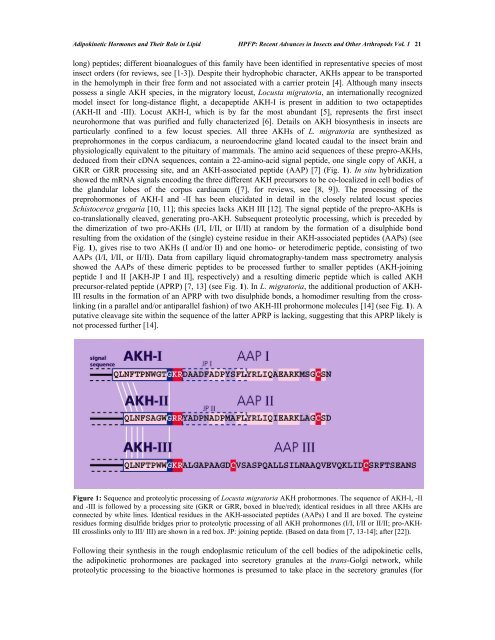chapter 1 - Bentham Science
chapter 1 - Bentham Science
chapter 1 - Bentham Science
Create successful ePaper yourself
Turn your PDF publications into a flip-book with our unique Google optimized e-Paper software.
Adipokinetic Hormones and Their Role in Lipid HPFP: Recent Advances in Insects and Other Arthropods Vol. 1 21<br />
long) peptides; different bioanalogues of this family have been identified in representative species of most<br />
insect orders (for reviews, see [1-3]). Despite their hydrophobic character, AKHs appear to be transported<br />
in the hemolymph in their free form and not associated with a carrier protein [4]. Although many insects<br />
possess a single AKH species, in the migratory locust, Locusta migratoria, an internationally recognized<br />
model insect for long-distance flight, a decapeptide AKH-I is present in addition to two octapeptides<br />
(AKH-II and -III). Locust AKH-I, which is by far the most abundant [5], represents the first insect<br />
neurohormone that was purified and fully characterized [6]. Details on AKH biosynthesis in insects are<br />
particularly confined to a few locust species. All three AKHs of L. migratoria are synthesized as<br />
preprohormones in the corpus cardiacum, a neuroendocrine gland located caudal to the insect brain and<br />
physiologically equivalent to the pituitary of mammals. The amino acid sequences of these prepro-AKHs,<br />
deduced from their cDNA sequences, contain a 22-amino-acid signal peptide, one single copy of AKH, a<br />
GKR or GRR processing site, and an AKH-associated peptide (AAP) [7] (Fig. 1). In situ hybridization<br />
showed the mRNA signals encoding the three different AKH precursors to be co-localized in cell bodies of<br />
the glandular lobes of the corpus cardiacum ([7], for reviews, see [8, 9]). The processing of the<br />
preprohormones of AKH-I and -II has been elucidated in detail in the closely related locust species<br />
Schistocerca gregaria [10, 11]; this species lacks AKH III [12]. The signal peptide of the prepro-AKHs is<br />
co-translationally cleaved, generating pro-AKH. Subsequent proteolytic processing, which is preceded by<br />
the dimerization of two pro-AKHs (I/I, I/II, or II/II) at random by the formation of a disulphide bond<br />
resulting from the oxidation of the (single) cysteine residue in their AKH-associated peptides (AAPs) (see<br />
Fig. 1), gives rise to two AKHs (I and/or II) and one homo- or heterodimeric peptide, consisting of two<br />
AAPs (I/I, I/II, or II/II). Data from capillary liquid chromatography-tandem mass spectrometry analysis<br />
showed the AAPs of these dimeric peptides to be processed further to smaller peptides (AKH-joining<br />
peptide I and II [AKH-JP I and II], respectively) and a resulting dimeric peptide which is called AKH<br />
precursor-related peptide (APRP) [7, 13] (see Fig. 1). In L. migratoria, the additional production of AKH-<br />
III results in the formation of an APRP with two disulphide bonds, a homodimer resulting from the crosslinking<br />
(in a parallel and/or antiparallel fashion) of two AKH-III prohormone molecules [14] (see Fig. 1). A<br />
putative cleavage site within the sequence of the latter APRP is lacking, suggesting that this APRP likely is<br />
not processed further [14].<br />
Figure 1: Sequence and proteolytic processing of Locusta migratoria AKH prohormones. The sequence of AKH-I, -II<br />
and -III is followed by a processing site (GKR or GRR, boxed in blue/red); identical residues in all three AKHs are<br />
connected by white lines. Identical residues in the AKH-associated peptides (AAPs) I and II are boxed. The cysteine<br />
residues forming disulfide bridges prior to proteolytic processing of all AKH prohormones (I/I, I/II or II/II; pro-AKH-<br />
III crosslinks only to III/ III) are shown in a red box. JP: joining peptide. (Based on data from [7, 13-14]; after [22]).<br />
Following their synthesis in the rough endoplasmic reticulum of the cell bodies of the adipokinetic cells,<br />
the adipokinetic prohormones are packaged into secretory granules at the trans-Golgi network, while<br />
proteolytic processing to the bioactive hormones is presumed to take place in the secretory granules (for

















